Research on the Spatiotemporal Evolution and Driving Factors of Forest Carbon Sink Increment—Based on Data Envelopment Analysis and Production Theoretical Decomposition Model
Abstract
1. Introduction
2. Literature Review
3. Research Methodology
3.1. Production Technology
- (1)
- If and , then ;
- (2)
- If and , then .
3.2. Decomposition Algorithm
3.3. Data Sources
4. Results
4.1. Analysis of Forest Carbon Sink Measurement in China
4.2. Measurement and Analysis of Incremental Forest Carbon Sinks in China
4.3. Trajectory of Incremental Center of Gravity of Forest Carbon Sinks in China
4.4. Analysis of Drivers of Forest Carbon Sinks in China
4.4.1. Analysis of the Results of the Decomposition of the Rate of Change of the Forest Carbon Sink and the Index of Change of Its Drivers
4.4.2. Analysis of the Dynamic Evolution of the Dominant Drivers Affecting Forest Carbon Sinks
5. Discussion
5.1. Research Contributions
5.2. Limitations and Future
6. Conclusions and Policy Recommendations
6.1. Conclusions
- (1)
- The spatial and temporal evolution of forest carbon sinks from a single indicator perspective includes four aspects: total forest carbon sinks, incremental forest carbon sinks, center of gravity shifts, and the rate of change in forest carbon sinks. From 2010 to 2021, forest carbon stocks in China and its three major regions exhibited a consistent annual increase, with an overall growth of 11.2%. Significant regional differences were observed in the dynamic changes of forest carbon sink increments, with the western and central regions exhibiting larger fluctuations, while the eastern region showed more stable growth. Furthermore, the gravity center of forest carbon sink increments in China shifted overall from the southwest to the northeast. Finally, the forest carbon sink change rate in China showed positive growth across both regions and provinces.
- (2)
- Research on the index decomposition of the rate of change in forest carbon sinks under a multi-dimensional driving mechanism: Using the production theoretical decomposition analysis (PDA) model, an index decomposition model was developed, focusing on changes in the technical efficiency of carbon sinks and the intensity of plant diseases and insect pests, with an exploration of their temporal and spatial evolution. Technical changes in carbon sinks and improvements in the technical efficiency of forest land use significantly enhance forest carbon sinks. In contrast, reductions in carbon sink efficiency, along with changes in the extent and intensity of forest pest and rodent infestations, have a detrimental effect. Notably, the dominant favorable drivers in the eastern and central regions exhibit consistent patterns of evolution. Moreover, the increased intensity of potential pest and rodent infestations may become a critical factor limiting the future enhancement of forest carbon sinks.
6.2. Policy Recommendations
- (1)
- Strengthening forest protection and ecological restoration. Inter-regional variations in research findings reveal significant differences in both the incremental amounts and rates of change of forest carbon sinks. Regions globally should implement differentiated forest management policies to account for variations in forest carbon sink potential across regions. Targeted protection and restoration strategies should be developed based on the trajectory of the shift in the forest carbon sink increment’s gravity center in each region. In regions with high forest carbon sink potential, ecological protection should be prioritized. Simultaneously, the maintenance and sustainable use of forest ecological benefits must be ensured in economically developed regions.
- (2)
- Strengthening forest pest and disease control. To counteract the negative impact of increasing forest disease, pest, and rodent intensity on forest carbon sink enhancement, the government should increase investments in prevention and control measures and enhance technology and response capabilities. The government should allocate more resources to forest pest and disease prevention, while enhancing control technologies and response capabilities. A monitoring and early warning system for pests, diseases, and rodents should be established, alongside strengthening the training of grassroots forestry staff in pest control techniques for timely detection and response. Simultaneously, attention should be given to changes in the intensity of potential forest pests and diseases, particularly in densely populated, economically developed regions.
- (3)
- Innovating and upgrading carbon sink-related technologies. Enhancing the technical efficiency of carbon sinks remains a goal that requires further development in each region. Cooperation and exchange in forest carbon sink management should be strengthened across regions. Successful experiences and technological achievements must be shared, and cross-regional projects should be promoted to ensure the optimal allocation and sharing of carbon sink resources. Simultaneously, the advanced technologies of leading regions should be actively promoted to enhance the technical efficiency of forest management in disadvantaged areas [49]. Investment in forestry research and development should be increased to promote technological upgrades, enhancing the carbon sequestration capacity of forest carbon sinks and ensuring the optimal allocation of resources.
Author Contributions
Funding
Data Availability Statement
Conflicts of Interest
References
- Wang, W.; He, T.; Lin, J.; Zhao, H.; Qin, Z.; Dai, K. Sino-US green finance cooperation (2016–2022)—An empirical analysis based on texts. J. Environ. Dev. 2023, 32, 307–322. [Google Scholar] [CrossRef]
- Ge, L.; Zhao, H.; Yang, J.; Yu, J.; He, T. Green finance, technological progress, and ecological performance-evidence from 30 Provinces in China. Environ. Sci. Pollut. Res. Int. 2022, 29, 66295–66314. [Google Scholar] [CrossRef] [PubMed]
- Vilkov, A.; Tian, G. Efficiency Evaluation of Forest Carbon Sinks: A Case Study of Russia. Forests 2024, 15, 649. [Google Scholar] [CrossRef]
- Meng, X.; Li, J.; Jin, M.; Su, X.; Suo, G. Research on Forest Carbon Sink Potential in China. Sustainability 2023, 15, 3589. [Google Scholar] [CrossRef]
- Ye, Y. Time-Varying Evolution and Impact Analysis of Forest Tourism Carbon Emissions and Forest Park Carbon Sinks in China. Forests 2024, 15, 1517. [Google Scholar] [CrossRef]
- Liu, W.; Guo, Z.; Lu, F.; Wang, X.; Zhang, M.; Liu, B.; Wei, Y.; Cui, L.; Luo, Y.; Zhang, L.; et al. The influence of disturbance and conservation management on the greenhouse gas budgets of China’s forests. J. Clean. Prod. 2020, 261, 121000. [Google Scholar] [CrossRef]
- Ge, J.; Lin, B. Convergence or divergence? Unraveling the global development pattern of forest carbon sink. Environ. Impact Assess. Rev. 2024, 105, 107442. [Google Scholar] [CrossRef]
- Zhu, J.J.; Gao, T.; Yu, L.Z.; Yang, K.; Sun, T.; Lu, D.L.; Liu, Z.H.; Chu, Y.D.; Zhang, J.X.; Teng, D.X.; et al. Carbon sink of forest ecosystems: Concept, time effect and improvement approaches. Ying Yong Sheng Tai Xue Bao 2024, 35, 2313–2321. [Google Scholar]
- Wang, L.; Chen, L.; Long, Y.; Li, C. Spatiotemporal evolution characteristics and spatial spillover effects of forest carbon sink efficiency in China. Env. Dev Sustain 2024, 1–33. [Google Scholar] [CrossRef]
- He, X.; Chen, L.; Huang, Y. A Study of Forest Carbon Sink Increment from the Perspective of Efficiency Evaluation Based on an Inverse DEA Model. Forests 2022, 13, 1563. [Google Scholar] [CrossRef]
- Wei, J.; Shen, M. Analysis of the Efficiency of, Forest Carbon Sinks and Its Influencing Factors-Evidence from China. Sustainability 2022, 14, 11155. [Google Scholar] [CrossRef]
- Bongers, F.; Chazdon, R.; Poorter, L.; Peña-Claros, M. The potential of secondary forests. Science 2015, 348, 642–643. [Google Scholar] [CrossRef]
- Haiou, C.; Min, L. Research on resource dynamics in the ninth forest inventory of China. West. For. Sci. 2020, 49, 90–95. [Google Scholar]
- Canadell, J.G.; Raupach, M.R. Managing Forests for Climate Change Mitigation. Science 2008, 320, 1456–1457. [Google Scholar] [CrossRef] [PubMed]
- Hautier, Y.; Tilman, D.; Isbell, F.; Seabloom, E.W.; Borer, E.T.; Reich, P.B. Anthropogenic environmental changes affect ecosystem stability via biodiversity. Science 2015, 348, 336–340. [Google Scholar] [CrossRef]
- Yao, R.; Hu, Z.; Guan, J. Interaction between forest carbon sinks and economic growth. For. Econ. Issues 2022, 42, 73–79. [Google Scholar]
- Hao, Y.; Xu, Y.; Zhang, J.; Hu, X.; Huang, J.; Chang, C.P.; Guo, Y. Relationship between forest resources and economic growth: Empirical evidence from China. J. Clean. Prod. 2019, 214, 848–859. [Google Scholar] [CrossRef]
- Hubau, W.; Lewis, S.L.; Phillips, O.L.; Affum-Baffoe, K.; Beeckman, H.; Cuní-Sanchez, A.; Daniels, A.K.; Ewango, C.E.; Fauset, S.; Mukinzi, J.M.; et al. Asynchronous carbon sink saturation in African and Amazonian tropical forests. Nature 2020, 579, 80–87. [Google Scholar] [CrossRef]
- Maia, V.A.; Santos, A.B.; de Aguiar-Campos, N.; de Souza, C.R.; de Oliveira, M.C.; Coelho, P.A.; Morel, J.D.; da Costa, L.S.; Farrapo, C.L.; Fagundes, N.C.; et al. The carbon sink of tropical seasonal forests in southeastern Brazil can be under threat. Sci. Adv. 2020, 6, eabd4548. [Google Scholar] [CrossRef]
- Song, Y.K. An empirical study on the relationship between economic growth and forest carbon sink value based on PVAR model. Front. Energy Res. 2023, 11, 1249144. [Google Scholar] [CrossRef]
- Meng, J.; Liang, C.; Chen, W. Research on the influence mechanism of heterogeneous environmental regulation on the growth of forest carbon sinks in China. J. Beijing For. Univ. (Soc. Sci. Ed.) 2024, 23, 42–51. [Google Scholar]
- Zhu, H.; Cai, Y.; Lin, H.; Tian, Y. Impacts of Cross-Sectoral Climate Policy on Forest Carbon Sinks and Their Spatial Spillover: Evidence from Chinese Provincial Panel Data. Int. J. Environ. Res. Public Health 2022, 19, 14334. [Google Scholar] [CrossRef] [PubMed]
- Zamolodchikov, D.G.; Grabovskii, V.I.; Shulyak, P.P.; Chestnykh, O.V. Recent decrease in carbon sink to Russian forests. Dokl. Biol. Sci. 2017, 476, 200–202. [Google Scholar] [CrossRef]
- Zhang, Z.; He, J.; Huang, M.; Zhou, W. Is Regulation Protection? Forest Logging Quota Impact on Forest Carbon Sinks in China. Sustainability 2023, 15, 13740. [Google Scholar] [CrossRef]
- Gong, R.F.; Zeng, W.Z. Comprehensive Performance Evaluation of Forestry Carbon Sequestration Projects–Taking Two CDM Forestry Carbon Sequestration Projects of Sichuan Province as Examples. IOP Conf. Ser. Earth Environ. Sci. 2019, 237, 022028. [Google Scholar] [CrossRef]
- Lin, B.; Ge, J. Carbon sinks and output of China’s forestry sector: An ecological economic development perspective. Sci. Total Environ. 2019, 655, 1169–1180. [Google Scholar] [CrossRef]
- Zhang, Y.; Yang, G.; Li, Z. Analysis of input-output efficiency of Beijing forestry based on DEA model. J. Beijing For. Univ. 2016, 38, 105–112. [Google Scholar]
- Zhang, W.; Zhu, Z.; Liu, X. Can green finance improve carbon emission efficiency? Environ. Sci. Pollut. Res. 2022, 29, 68976–68989. [Google Scholar] [CrossRef]
- Xu, Z. Research on the Impact of Digital Green Finance on Agricultural Green Total Factor Productivity: Evidence from China. Agriculture 2024, 14, 1151. [Google Scholar] [CrossRef]
- Liu, X.; Huang, J.; Zhou, H.; Sun, J.; Wang, Q.; Cheng, X. Dynamic Analysis of Provincial Forest Carbon Storage Efficiency in China Based on DEA Malmquist Index. Forests 2023, 14, 1629. [Google Scholar] [CrossRef]
- Zhao, S.; Shi, W.; Qiao, F.; Wang, C.; An, Y.; Zhang, L. Temporal and Spatial Changes and Trend Predictions of Forest Carbon Sequestration Efficiency in China Based on the Carbon Neutrality Goal. Forests 2023, 14, 2387. [Google Scholar] [CrossRef]
- Xia, C.; Wang, Z.; Xu, G.; Dong, X. Quantitative decomposition of China’s industrial energy consumption structure based on production-theoretical decomposition method. J. Clean. Prod. 2022, 379, 134467. [Google Scholar] [CrossRef]
- Zhang, X.; Zhang, R.; Feng, C.; Wang, Y.; Zhao, M.; Zhao, X. Decomposition analysis of renewable energy demand and coupling effect between renewable energy and energy demand: Evidence from China. Renew. Energy 2024, 237, 121839. [Google Scholar] [CrossRef]
- Ding, L.; Zhang, K.; Yang, Y. Carbon emission intensity and biased technical change in China’s different regions: A novel multidimensional decomposition approach. Environ. Sci. Pollut. Res. 2022, 29, 38083–38096. [Google Scholar] [CrossRef]
- Chen, L.D.Q. Decomposition analysis of factors driving CO2 emissions in Chinese provinces based on production-theoretical decomposition analysis. Nat. Hazards 2016, 84 (Suppl. S1), 267–277. [Google Scholar] [CrossRef]
- Liu, B.; Shi, J.; Wang, H.; Su, X.; Zhou, P. Driving factors of carbon emissions in China: A joint decomposition approach based on meta-frontier. Appl. Energy 2019, 256, 113986.1–113986.11. [Google Scholar] [CrossRef]
- Lin, B.; Du, K. What is the driving force of energy productivity growth in China: Decomposition based on distance function. J. Financ. Res. 2013, 9, 84–96. [Google Scholar]
- Wang, H.; Zhou, P.; Xie, B.C.; Zhang, N. Assessing drivers of CO2 emissions in China’s electricity sector: A meta frontier production-theoretical decomposition analysis. Eur. J. Oper. Res. 2019, 275, 1096–1107. [Google Scholar] [CrossRef]
- Liu, X.; Zhou, D.; Zhou, P.; Wang, Q. What drives CO2 emissions from China’s civil aviation? An exploration using a new generalized PDA method. Transport. Res. Pol. Pract. 2017, 99, 30–45. [Google Scholar] [CrossRef]
- Li, J.; Meng, G.; Li, C.; Du, K. Tracking carbon intensity changes between China and Japan: Based on the decomposition technique. J. Clean. Prod. 2022, 349, 131090. [Google Scholar] [CrossRef]
- Wang, H.; Li, R.; Zhang, N.; Zhou, P.; Wang, Q. Assessing the role of technology in global manufacturing energy intensity change: A production-theoretical decomposition analysis. Technol. Forecast. Soc. Change 2020, 160, 120245. [Google Scholar] [CrossRef]
- Liu, X.; Chen, H.; Peng, C.; Li, M. Assessing the Drivers of Carbon Intensity Change in China: A Dynamic Spatial–Temporal Production-Theoretical Decomposition Analysis Approach. Sustainability 2022, 14, 12359. [Google Scholar] [CrossRef]
- Chen, H.; Qi, S.; Tan, X. Decomposition and prediction of China’s carbon emission intensity towards carbon neutrality: From perspectives of national, regional and sectoral level. Sci. Total Environ. 2022, 825, 153839. [Google Scholar] [CrossRef] [PubMed]
- Liu, B.; Meng, L.; Nie, B.; Shi, J.; Li, Y. Regional disparities and drivers of carbon emissions in China: A temporal-spatial production-theoretical decomposition analysis. Sci. Prog. 2023, 106, 368504231163145. [Google Scholar] [CrossRef]
- Wang, Y.; Huang, H. Decoupling effect, spatial-temporal characteristics and driving factors of carbon emissions in China. Acta Ecol. Sin. 2024, 44, 2228–2243. [Google Scholar]
- Bai, J.; Jiang, F. Research on regional innovation efficiency considering environmental factors: Based on three-stage DEA method. Financ. Trade Econ. 2011, 10, 104–112+136. [Google Scholar]
- Kaya, Y. Impact of Carbon Dioxide Emission Control on GNP Growth: Interpretation of Proposed Scenarios; IPCC Energy and Industry Subgroup, Response Strategies Working Group: Geneva, Switzerland, 1990. [Google Scholar]
- Lesiv, L.F.S. A spatial assessment of the forest carbon budget for Ukraine. Mitig. Adapt. Strateg. Glob. Change 2019, 24, 985–1006. [Google Scholar] [CrossRef]
- Huang, Y.; Wang, J.; Yu, H. Evaluation of forest carbon sink value in collective forest area: Based on evidence reasoning method. For. Econ. Issues 2024, 44, 32–41. [Google Scholar]
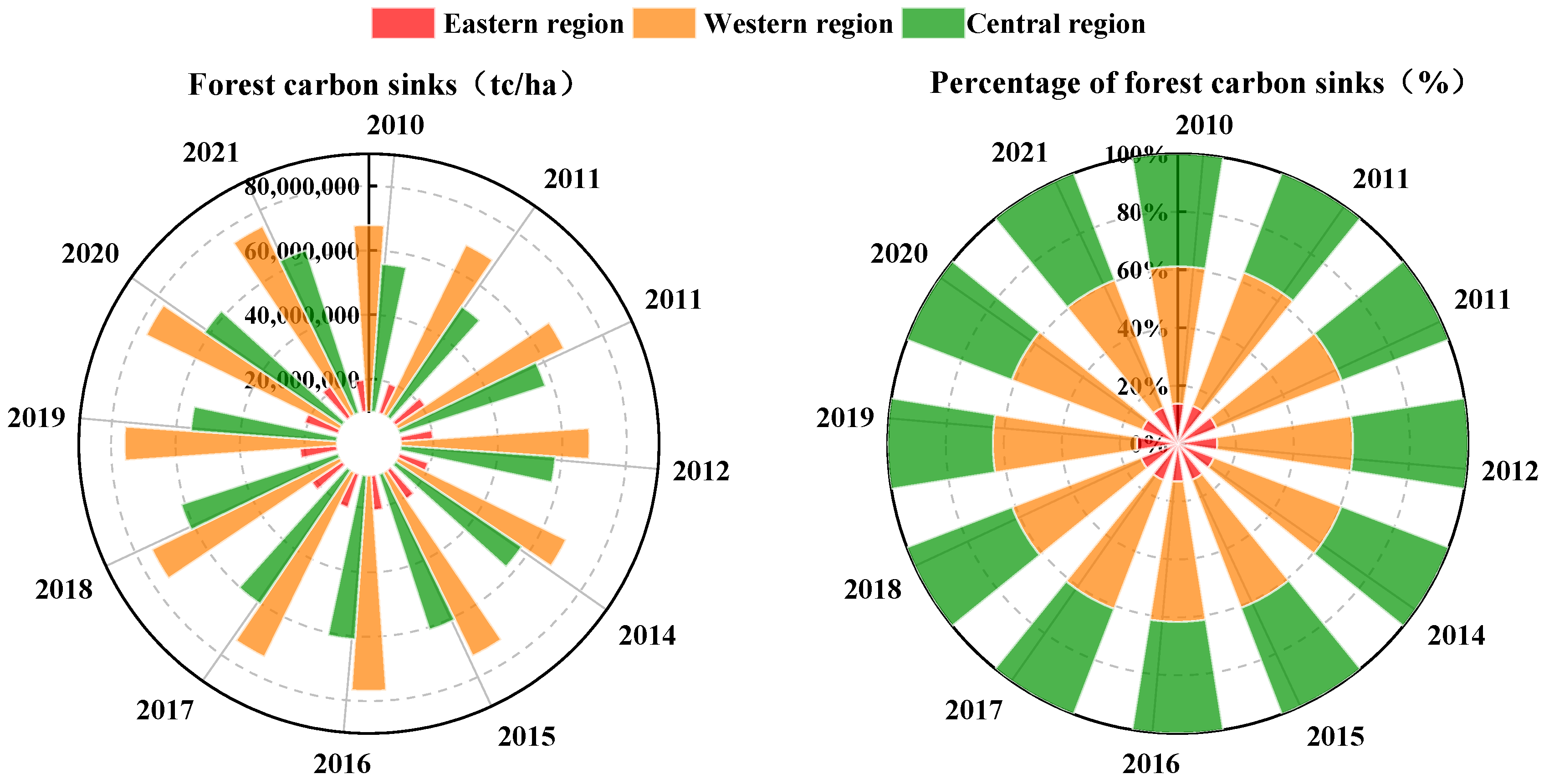
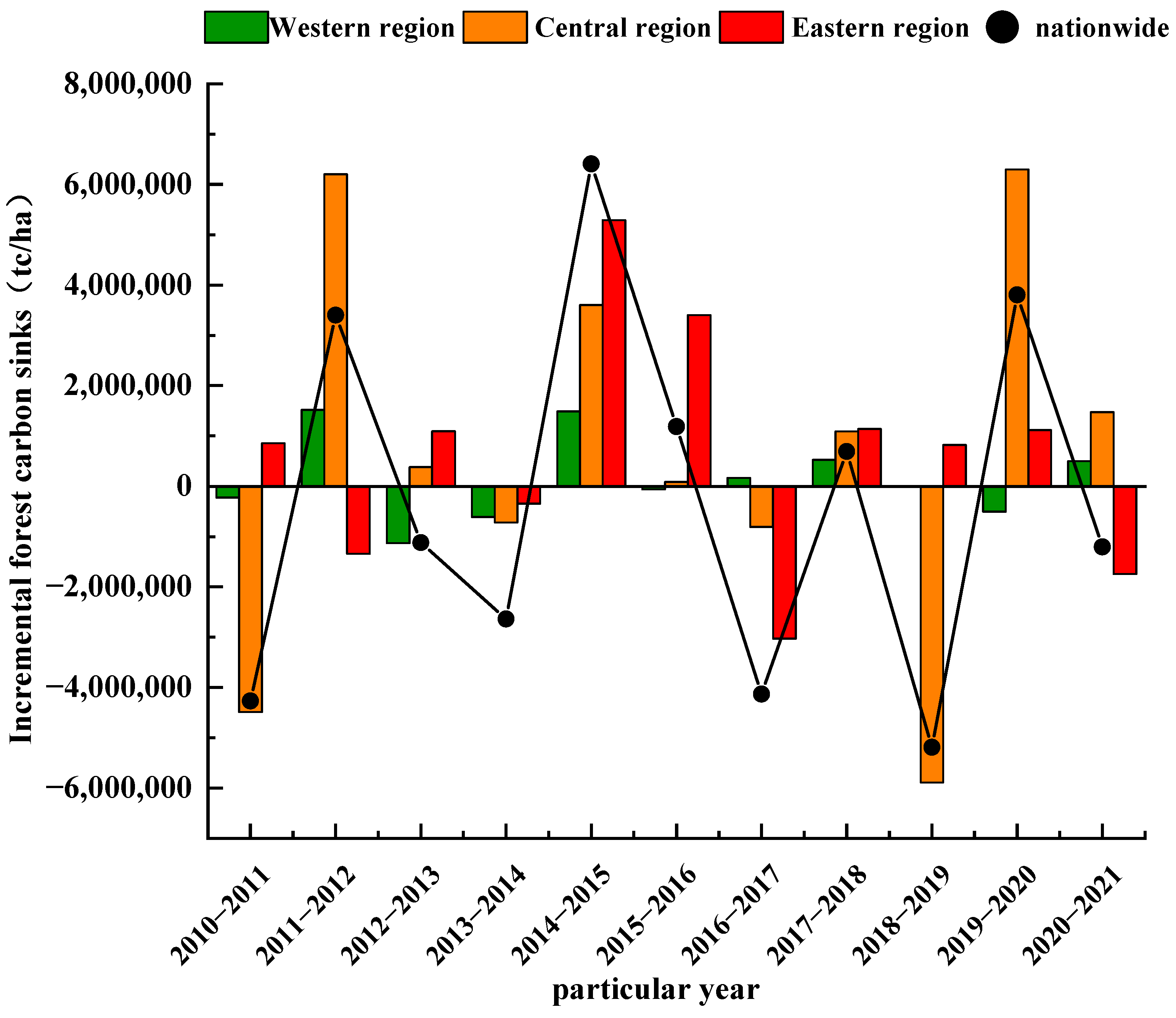
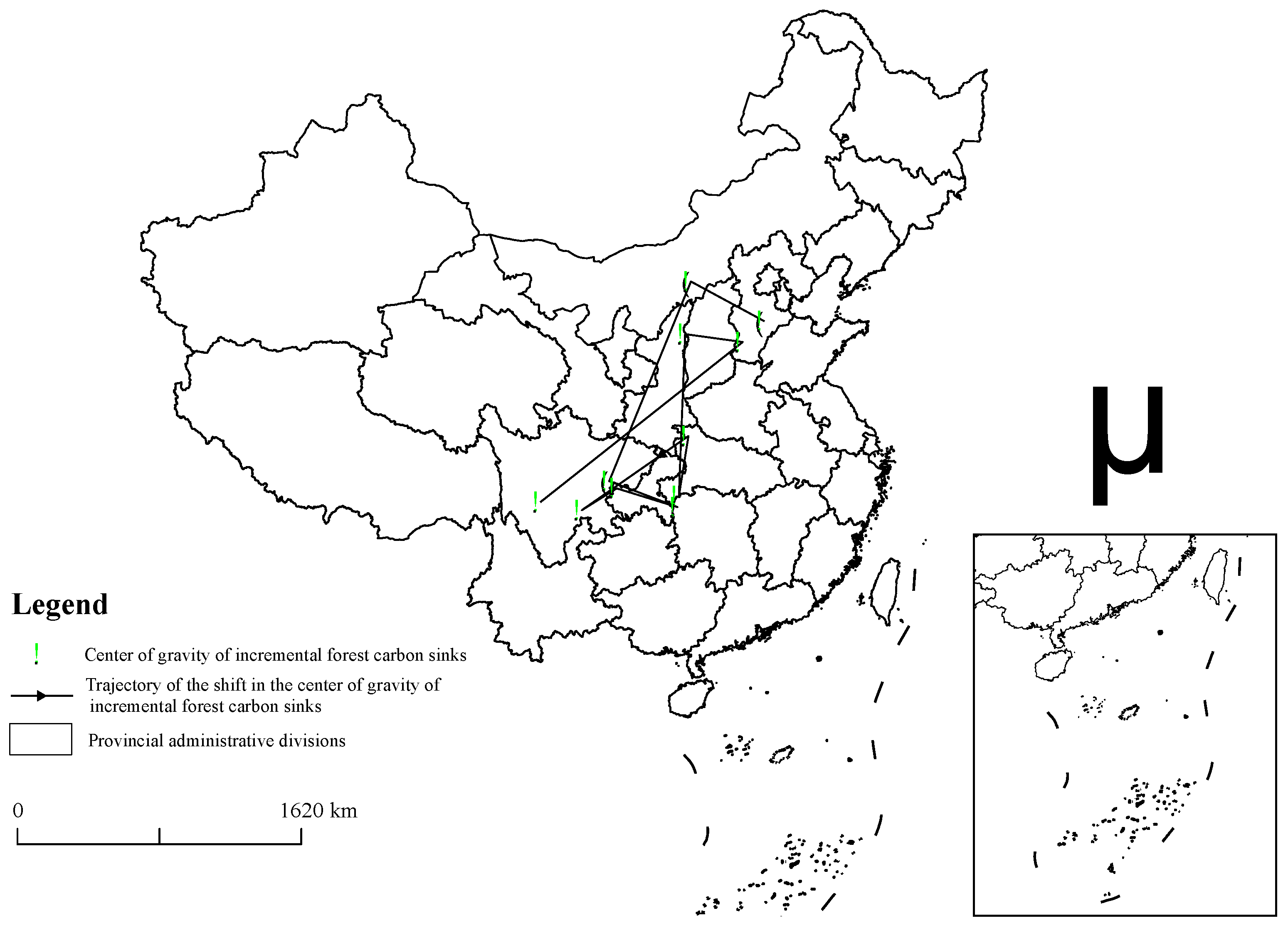

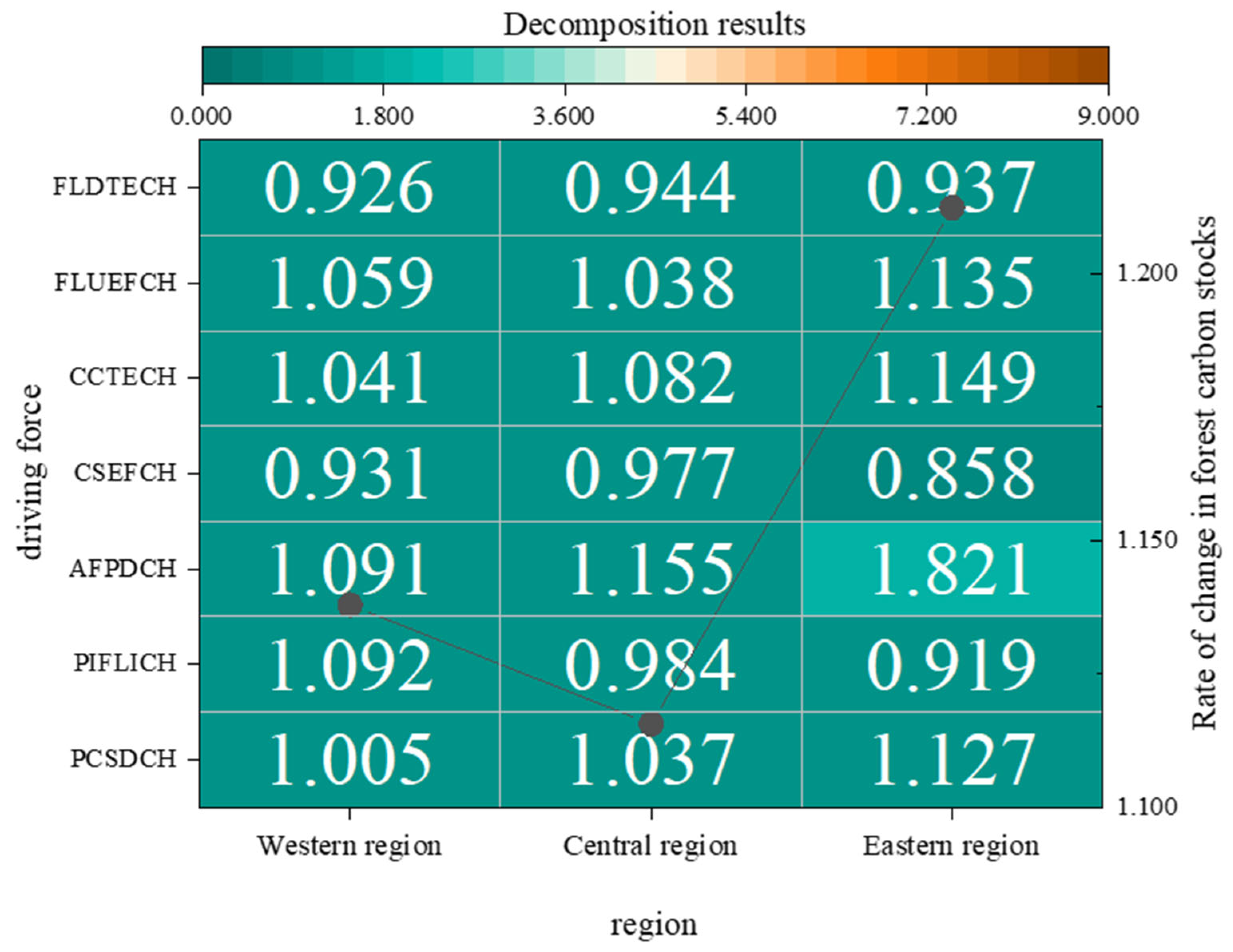
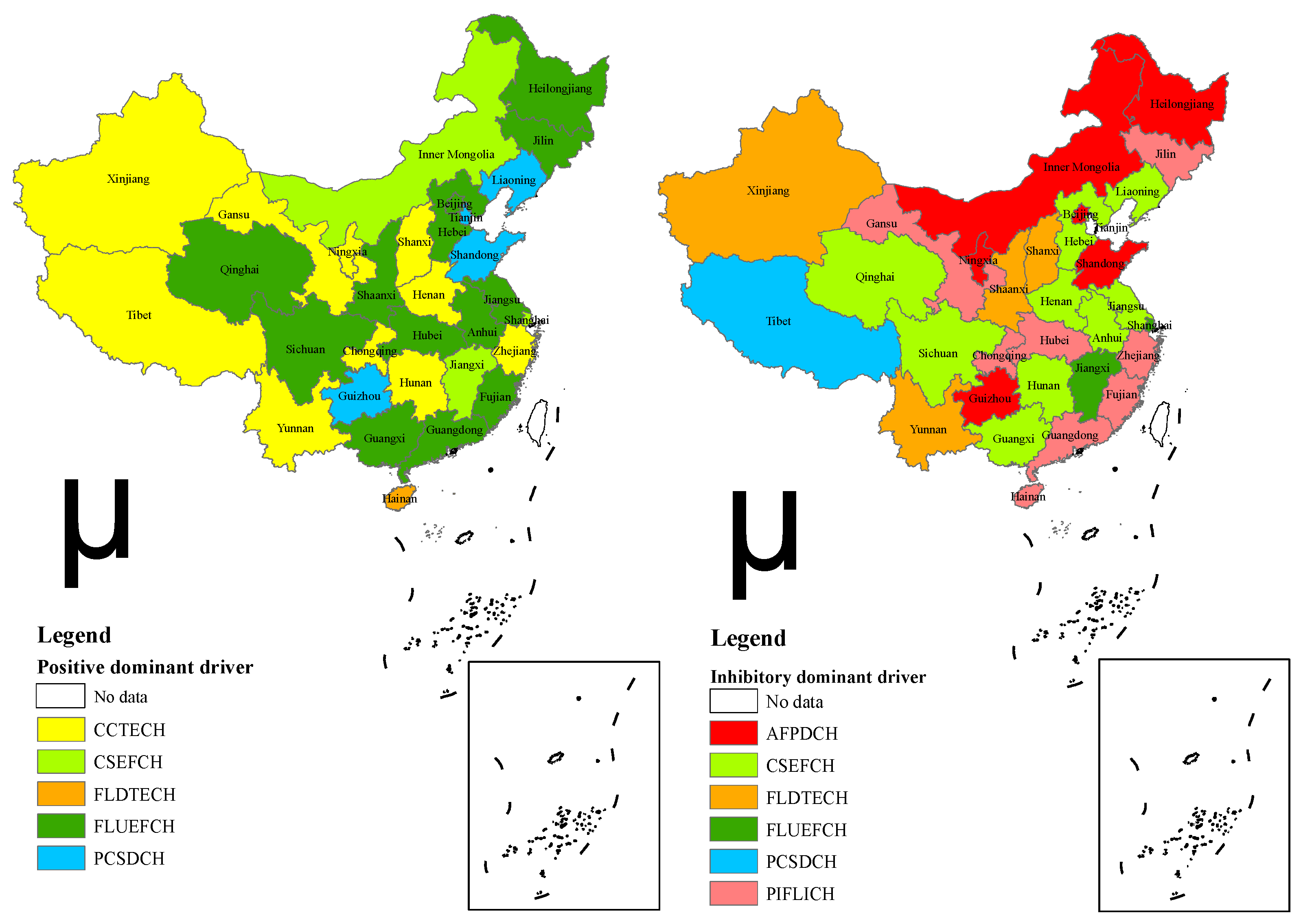
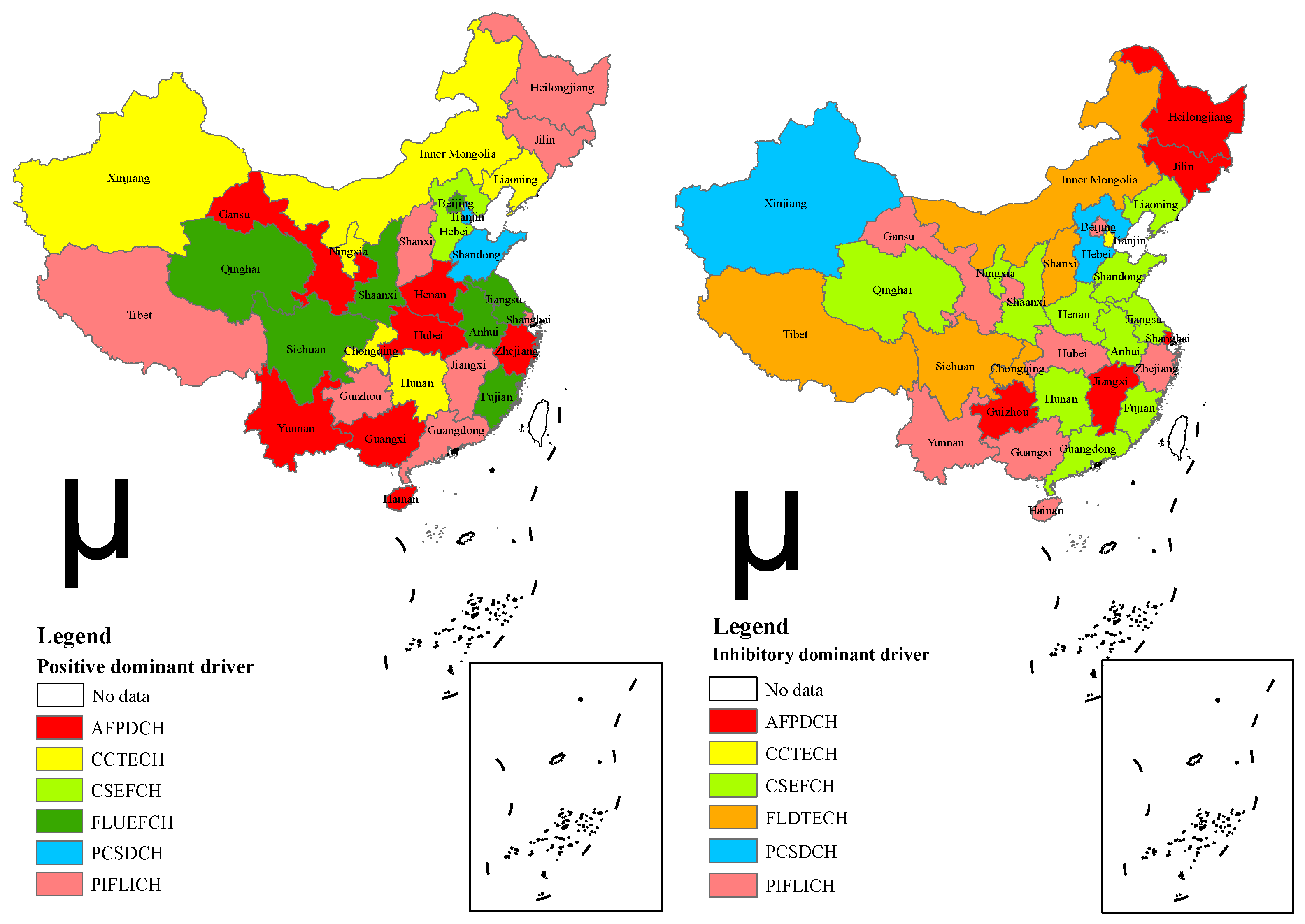
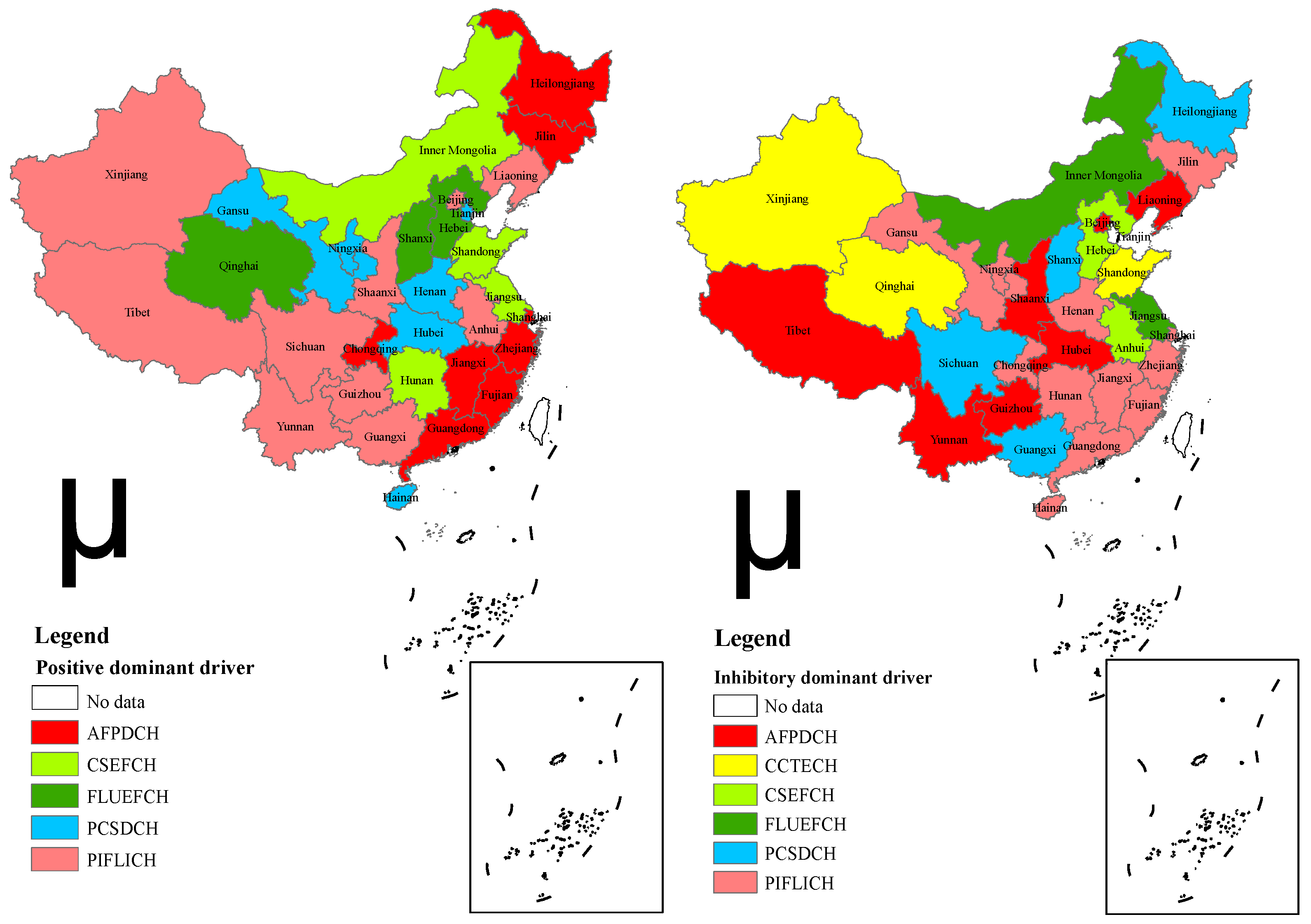

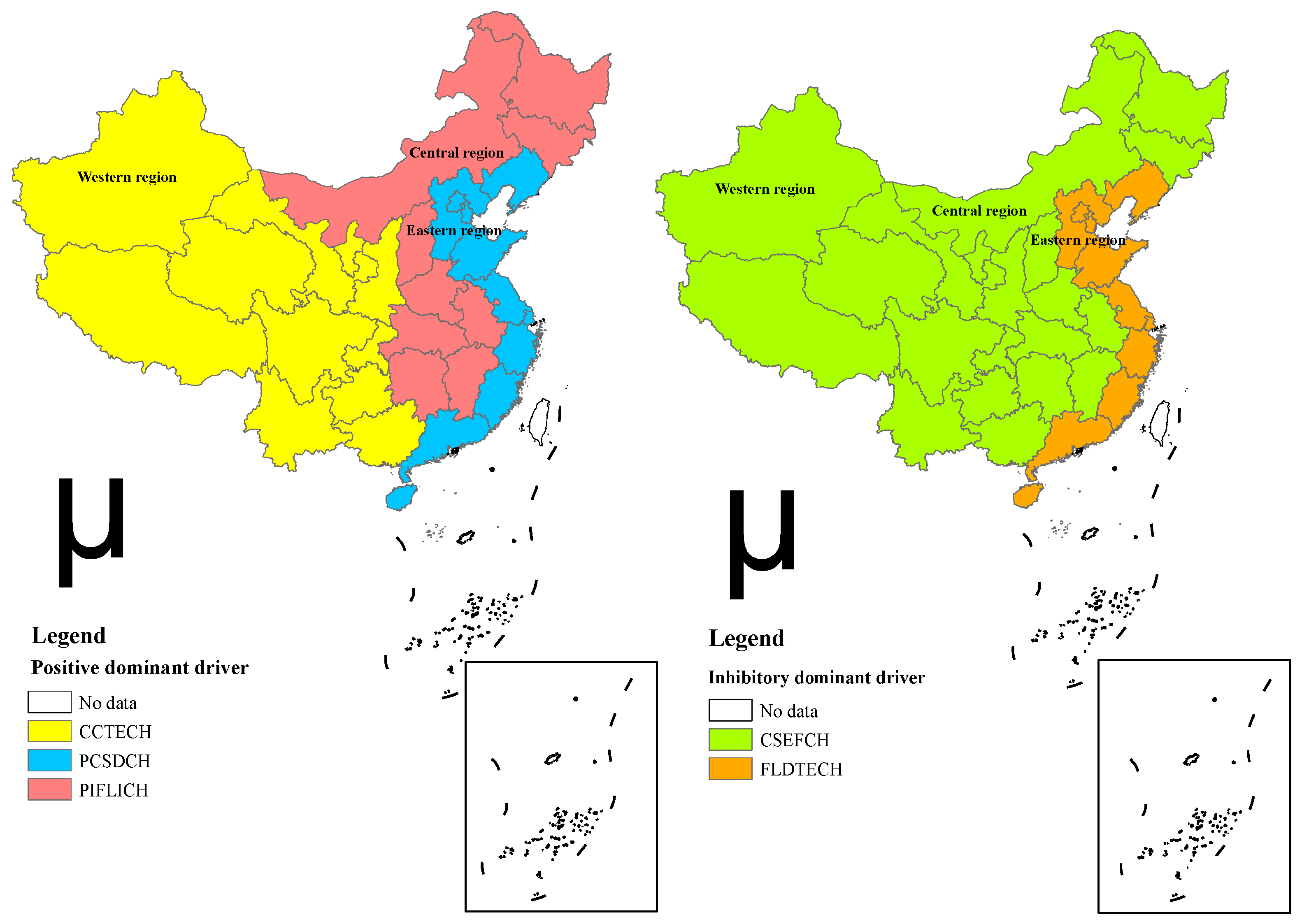
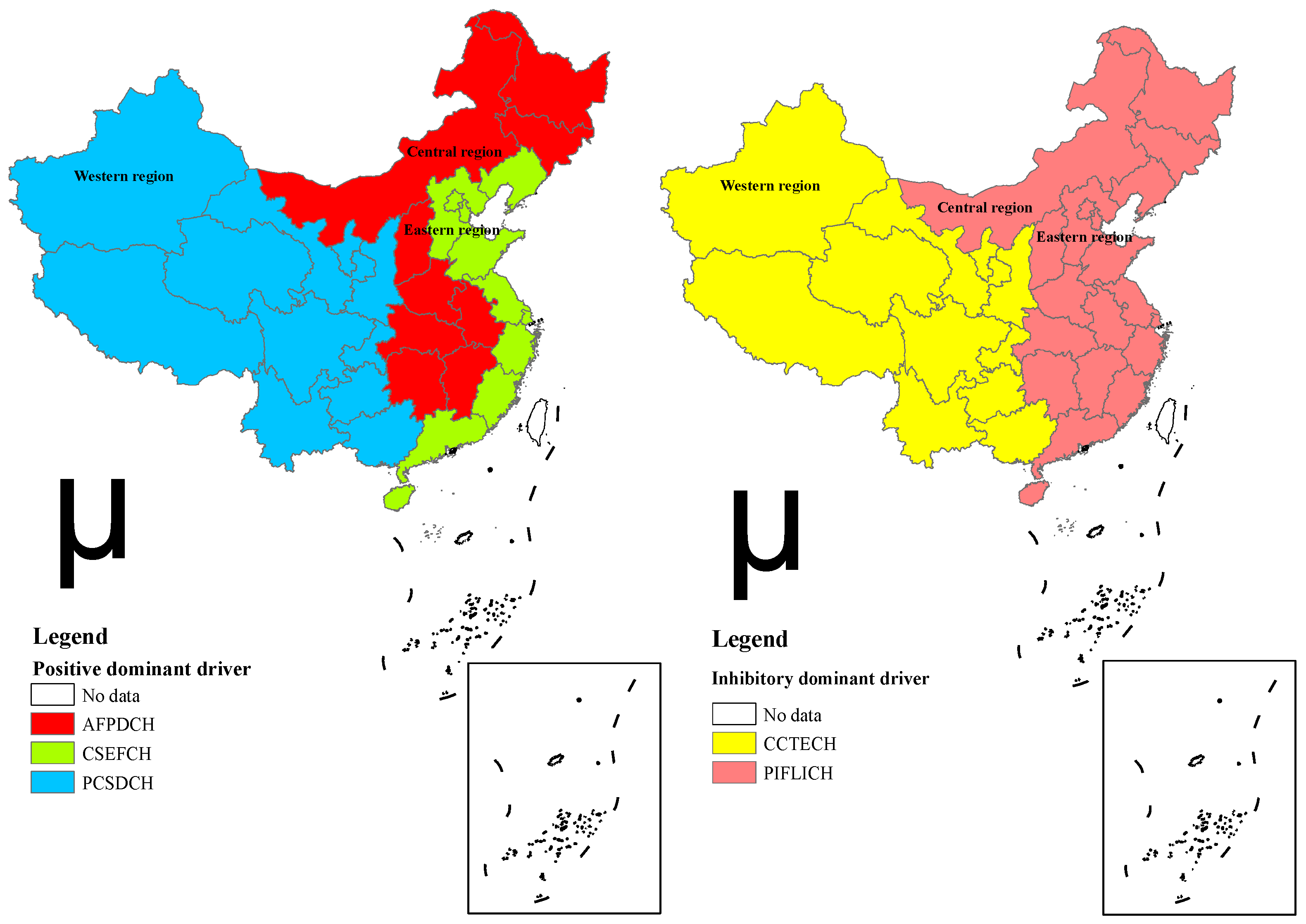
| Author(s) (Year) | Main Conclusion | Methodology |
|---|---|---|
| Hubau et al. [18] | Carbon loss caused by tree death is the cause of divergent responses of carbon sinks in tropical forests. | Multi-parameter models |
| Song et al. [20] | Economic growth has a positive impact on forest carbon sink. | Empirical test |
| Zhu et al. [22] | Cross sectoral climate policies have a positive impact on forest carbon sinks. | Empirical test |
| Zhang et al. [27] | From 1993 to 2013, Beijing’s forestry input–output comprehensive efficiency was high, and the input–output status was good, the efficiency was generally stable, and the fluctuation was small. | DEA |
| Lingui et al. [9] | Digital green finance contributes to the improvement of agricultural green total factor productivity. | SBM |
| Duan and Chen [35] | Changes in scale effect and change in inputs were the main factors driving CO2 emissions growth. | PDA |
| Lili et al. [40] | Output biased technical change and the magnitude of technical change are the critical factors in China’s carbon emission intensity. | PDA and IDA |
| Xiaolei et al. [42] | Energy intensity was the dominant driver to reduce carbon intensity, and technological changes also played a great role in decreasing carbon intensity. Conversely, carbon emissions efficiency had negative effects on reducing carbon intensity. | DST-PDA |
| Bingquan et al. [36] | Carbon emission efficiency and potential carbon factor were the two important factors related to increase carbon emissions. | PDA and IDA |
Disclaimer/Publisher’s Note: The statements, opinions and data contained in all publications are solely those of the individual author(s) and contributor(s) and not of MDPI and/or the editor(s). MDPI and/or the editor(s) disclaim responsibility for any injury to people or property resulting from any ideas, methods, instructions or products referred to in the content. |
© 2025 by the authors. Licensee MDPI, Basel, Switzerland. This article is an open access article distributed under the terms and conditions of the Creative Commons Attribution (CC BY) license (https://creativecommons.org/licenses/by/4.0/).
Share and Cite
Wang, J.; Zhang, M.; Zhou, S.; Huang, Y. Research on the Spatiotemporal Evolution and Driving Factors of Forest Carbon Sink Increment—Based on Data Envelopment Analysis and Production Theoretical Decomposition Model. Forests 2025, 16, 104. https://doi.org/10.3390/f16010104
Wang J, Zhang M, Zhou S, Huang Y. Research on the Spatiotemporal Evolution and Driving Factors of Forest Carbon Sink Increment—Based on Data Envelopment Analysis and Production Theoretical Decomposition Model. Forests. 2025; 16(1):104. https://doi.org/10.3390/f16010104
Chicago/Turabian StyleWang, Jiawei, Mengjiao Zhang, Shihe Zhou, and Yan Huang. 2025. "Research on the Spatiotemporal Evolution and Driving Factors of Forest Carbon Sink Increment—Based on Data Envelopment Analysis and Production Theoretical Decomposition Model" Forests 16, no. 1: 104. https://doi.org/10.3390/f16010104
APA StyleWang, J., Zhang, M., Zhou, S., & Huang, Y. (2025). Research on the Spatiotemporal Evolution and Driving Factors of Forest Carbon Sink Increment—Based on Data Envelopment Analysis and Production Theoretical Decomposition Model. Forests, 16(1), 104. https://doi.org/10.3390/f16010104




